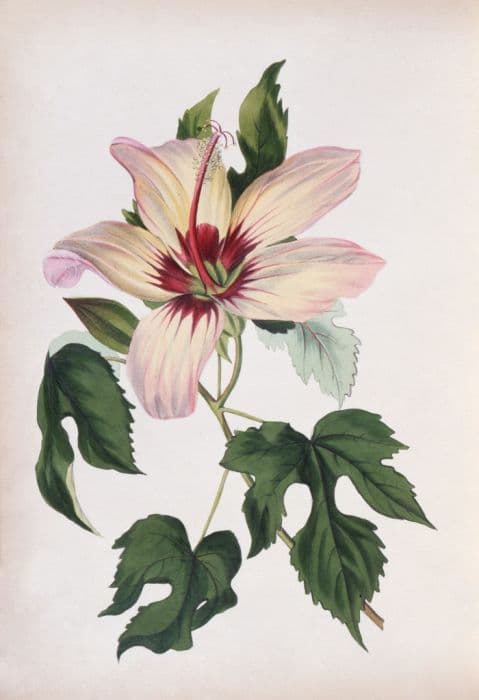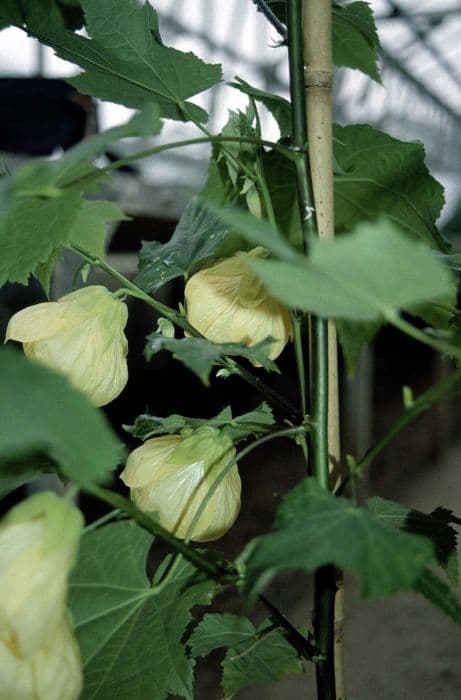Rose of Sharon 'Stadt Erlenbach' Hibiscus syriacus 'Stadt Erlenbach'

ABOUT
'Stadt Erlenbach' is an upright shrub up to 2.5m high, with deciduous, three-lobed, green leaves, and semi-double lilac flowers, with dark red centres and veins, from late summer to mid-autumn
About this plant
 Names
NamesSynonyms
Rose of Sharon, Shrub Althea, Hardy Hibiscus
Common names
Hibiscus syriacus 'Stadt Erlenbach'.
 Characteristics
CharacteristicsLife cycle
Perennials
Foliage type
Deciduous
Color of leaves
Green
Flower color
Mixed
Height
8-12 feet (2.4-3.7 meters)
Spread
6-10 feet (1.8-3 meters)
Plant type
Shrub
Hardiness zones
5
Native area
Asia
Benefits
 General Benefits
General Benefits- Ornamental Value: Adds visual appeal with its large, vibrant flowers that bloom in late summer.
- Drought Tolerance: Once established, it can tolerate periods of low water availability, making it suitable for xeriscaping.
- Low Maintenance: Requires minimal care beyond initial planting and occasional pruning to maintain shape and encourage blooming.
- Cold Hardy: Capable of withstanding cooler temperatures and is suitable for growing in USDA hardiness zones 5-8.
- Attracts Wildlife: The blossoms attract bees, butterflies, and other pollinators, supporting the local ecosystem.
- Privacy Screen: Can be used as a hedge or privacy screen due to its dense foliage.
- Variability: Offers gardeners a range of colors with the potential for various shades of flowers.
- Long Blooming Period: The blooming period extends from mid-summer until fall, providing season-long interest.
- Adaptability: Can be planted in a variety of soil types, although it prefers well-drained soils.
- Non-Invasive: Unlike other hibiscus species, it does not aggressively spread, which minimizes the need for containment.
 Medical Properties
Medical Properties- This plant is not used for medical purposes.
 Air-purifying Qualities
Air-purifying QualitiesThis plant is not specifically known for air purifying qualities.
 Other Uses
Other Uses- Hibiscus syriacus, commonly known as Rose of Sharon, can be used as a natural dye for fabrics, where the flowers impart a delicate pinkish-purple hue.
- The bark of the Rose of Sharon has been traditionally used for rope making due to its strong fibrous quality.
- The flowers of the Rose of Sharon can be used in culinary dishes, adding a mild flavor and a burst of color to salads and desserts.
- The wood of Rose of Sharon is compact and can be carved into small items like utensils, combs, or decorative objects.
- Leaves from the Rose of Sharon can be brewed into a mild tea; although not common, it can be a soothing drink similar to other herbal teas.
- During blooming season, the Rose of Sharon can serve as an educational tool in schools for botany and pollination studies due to its attractive flowers.
- In some cultures, parts of the Rose of Sharon plant may be used in crafting traditional headwear or adornments for cultural festivals.
- The Rose of Sharon's sturdy branches can be used as natural garden stakes for supporting other plants in the garden.
- Dried Rose of Sharon blossoms can be incorporated into potpourri mixes for their appearance and faint natural scent.
- Artists can use the petals of the Rose of Sharon to create organic watercolor paints by extracting the juices from the flowers.
Interesting Facts
 Feng Shui
Feng ShuiRose of Sharon is not used in Feng Shui practice.
 Zodiac Sign Compitability
Zodiac Sign CompitabilityRose of Sharon is not used in astrology practice.
 Plant Symbolism
Plant Symbolism- Delicate Beauty: Hibiscus flowers, with their colorful and large petals, often symbolize delicate beauty and a sense of gentleness.
- Femininity: The softness and delicate structure of the Hibiscus is frequently associated with femininity and the grace and elegance of a woman.
- Warmth and Hospitality: In some cultures, Hibiscus, particularly the red varieties, are used to symbolize warmth, hospitality, and a welcoming atmosphere.
- Temporary Nature of Fame or Personal Glory: Because Hibiscus flowers bloom for a short time before wilting, they are sometimes used to represent the fleeting nature of fame or personal glory.
- Carpe Diem: The transient life of the Hibiscus bloom is also a reminder to "seize the day" and live life to the fullest.
 Water
WaterThe Rose of Sharon requires regular watering, particularly during dry spells, to keep the soil evenly moist. New plantings should be watered once or twice per week, depending on the weather, applying about 1 to 2 gallons per watering to establish a strong root system. Established plants will benefit from a similar amount of water, but they can withstand somewhat drier conditions. Care should be taken not to over-water, as this can lead to root rot. Deep, infrequent waterings are better than frequent, shallow ones, as this encourages deeper root growth.
 Light
LightThe Rose of Sharon thrives best in full sun conditions, where it can receive at least six to eight hours of direct sunlight daily. While it can tolerate partial shade, flowering is often more prolific in full sun. The plant should be placed in a spot where it isn't shaded by buildings or larger trees to ensure adequate light for bloom production.
 Temperature
TemperatureThe Rose of Sharon is hardy and can tolerate a wide range of temperatures, typically from 20°F to over 100°F. However, it grows best in temperatures between 60°F and 85°F. It is important to protect the plant from extreme cold by planting it in a location sheltered from harsh winter winds.
 Pruning
PruningPruning the Rose of Sharon is important for maintaining its shape, encouraging new growth, and promoting more prolific blooming. The best time to prune is late winter or early spring before new growth starts. Prune away any dead or diseased wood, and thin out crowded branches. You can also prune to shape the plant or control its size; it tolerates heavy pruning well.
 Cleaning
CleaningAs needed
 Soil
SoilThe best soil mix for the Rose of Sharon is one that is well-draining and fertile. A good mix could be composed of two parts loam, one part peat moss, and one part perlite or coarse sand to facilitate drainage. This plant prefers a slightly acidic to neutral pH range, ideally between 5.5 and 7.5.
 Repotting
RepottingRose of Sharon, being a larger shrub rather than a houseplant, typically does not require repotting. It is planted in the ground where it can grow to its full size. Repotting would apply to container-grown plants and should be done every 3-5 years or when the plant outgrows its current container.
 Humidity & Misting
Humidity & MistingRose of Sharon can tolerate a broad range of humidity conditions, but it thrives best in moderate to high humidity. There is no specific humidity level required, but maintaining ambient outdoor humidity is generally suitable for the plant.
 Suitable locations
Suitable locationsIndoor
Provide bright light and prune to control size.
Outdoor
Plant in full sun, ensure soil is well-draining.
Hardiness zone
5-9 USDA
 Life cycle
Life cycleHibiscus syriacus 'Stadt Erlenbach', commonly known as Rose of Sharon, begins its life cycle with seed germination in late spring to early summer, requiring well-drained soil and full to partial sunlight. Following germination, the seedling stage involves the development of primary leaves and a basic root system. As the plant enters the vegetative stage, it grows vigorously, producing a woody stem and more complex leaf structures, preparing for the flowering stage. During the flowering stage, typically from mid-summer to fall, 'Stadt Erlenbach' produces large, showy flowers that are attractive to pollinators, eventually leading to seed production. Once pollinated, the flowers produce seeds that are dispersed by wind, water, or animals, completing the reproductive cycle. In the perennial phase, the plant experiences a dormancy period in winter, during which above-ground growth ceases, but it emerges again in spring, ready for a new growth cycle.
 Propogation
PropogationPropogation time
Spring to Summer
The Hibiscus syriacus 'Stadt Erlenbach', commonly known as Rose of Sharon, is typically propagated during late winter to early spring, before new growth begins. The most popular method of propagation is through softwood cuttings. To do this, a gardener would take a cutting of new growth about 4 to 6 inches (approximately 10 to 15 centimeters) long, strip the leaves from the lower half, and dip the cut end into rooting hormone. This prepared cutting is then inserted into a rooting medium, such as perlite or vermiculite, ensuring that the leafless portion is well covered. The cutting should be kept in a well-lit area but out of direct sunlight, and the medium should be kept consistently moist but not waterlogged. With proper care, roots will develop within a few weeks, after which the new Rose of Sharon plant can be transplanted to a more permanent location.









